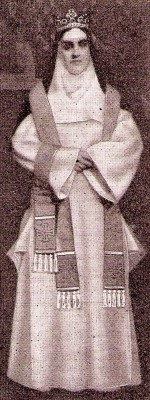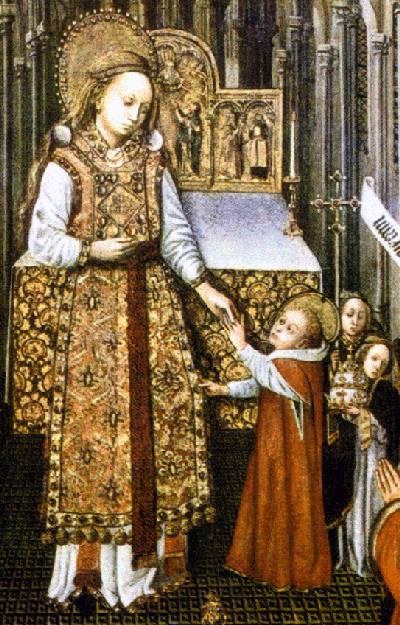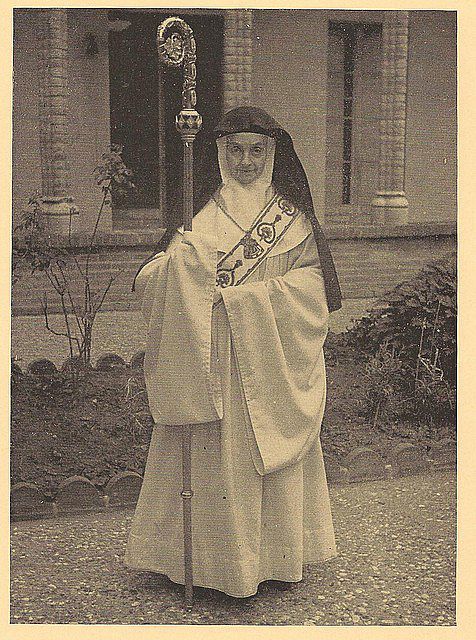At times within the history of the Church, abbesses wore the stole, carried the crosier and even wore the mitre and ring, just like their male counterparts!
Mitred abbesses certainly existed, but some seemed to extend their privileges a little more.
Of Mitres, Mitred Abbesses and Clerical Kings
Discussing the phenomenon of mitred abbesses today it is hard not to bring up issues of women's ordination. The comparison, however, largely serves to underscore the difference between the authority the great abbesses of mediaeval days wielded and that which would-be priestesses desire. The mitred abbess, and her regal Germanic cousin the princess-abbess (Reichsäbtissin, Fürstäbtissin) are creations of medieval Christendom, rather than a mythical feminist early Christianity populated by misunderstood bishops' wives turned by a linguistic trick into bishopesses. While abbesses reportedly signed the canons of the Synod of Whitby ahead of the priests present, there is a long and sizable gap between the obsolenscence of (unordained) deaconesses and the appearance of the first mitred abbess. In the extraordinary instances where abbesses overstepped their bounds and claimed some share of sacerdotal authority, it was more a matter of personal aggrandisement unconnected with their legal feudal rights and unlinked to some wider ideology.
The disappearance of the abbess as a political figure also seems in part accountable to the neo-classical biases of the Renaissance that reintroduced to Europe a pre-Christian Roman legal attitude that barred women from the comparative liberties of the Middle Ages. A queen or duchess ruling in the stead of her absent husband or underaged son fit more clearly into the feudal system than into the absolutist monarchies of the seventeenth and eighteenth centuries. The abbess--often ruling over numerous local fiefs, holding sizable feudal rights, and sitting on the local imperial Council of Prelates alongside abbots and the occasional bishop--was a continuation of that custom. The abbess's "official" source of power was as a temporal ruler, which nonetheless testifies to the broad-mindedness of the Middle Ages with regards to female authority. In the few instances where her official power was ecclesiastical (as in the extraordinary case of the abbess-nullius of Las Huelgas in Spain), it was juridical rather than sacramental.
There were comparatively few mitred abbesses as opposed to Reichsäbtissinen; I know of only two for certain--Las Huelgas in Spain, Conversano in Italy. There were at probably quite a few others, such as Nonnburg in Austria, whose abbess may have been mitred at one time if I recall correctly, and wore a ceremonial crown as late as the 1920s. Their rights to partial pontificalia date back to a time when the mitre was itself comparatively new, and confined to the pope and cardinals. Shortly thereafter we find a veritable surfeit of mitred privileges granted to notable foreign bishops, abbots, cathedral canons (whose use actually predates that of abbots, as in the case of the chapter of Besançon that dates back to 1051), and even temporal rulers.
The case of mitred kings is particularly interesting, representing the ideal of close relations between pontiff and ruler, as well as the ruler as serving as an icon of Christ the King. In some cases, the lines between spiritual and temporal started getting blurred in some places, as at least one authority reports that during the High Middle Ages the Holy Roman Emperor would be ordained as a priest before his coronation, a priesthood admittedly without responsibilities, but a priesthood all the same. Incidentally, the Emperor also had the peculiar right to sing the Christmas Gospel with a drawn sword, and also honorary membership in several cathedral chapters.
However, the mitre was usually bestowed on most worthy kings as a sign of fealty to Rome, and did not accompany ordination. The oldest example of such a privilege goes back to Nicholas II, who granted the mitre to Duke Spytihnev of Bohemia, while Alexander II decorated his successor Vratislas in the same fashion. Roger of Sicily purportedly received the right to the mitre, along with crozier, ring, dalmatic and sandals from Lucius II. Regal robes, for that matter, often hinted at the ecclesial, and indeed at the coronation of Elizabeth II in 1953, the traditional robes included garments closely patterned on a dalmatic and a stole. This has less to do with women's ordination than the quasi-sacerdotal charisma that attached itself to kingship in medieval days.
It is in this context that one can make the most sense of mitred abbesses. The abbess of Conversano acquired for herself the right to a pectoral cross, ring, crozier and mitre at some point--though the crozier itself is hardly unusual and is still a symbol of their authority today. There was some abuse of this power, as she claimed canonical power over the clergy (not unlike many kings and dukes who interfered in the appointment of bishops), and annually received their homage while solemnly vested in her ornaments. For this she was nicknamed the "Monster of Apulia" and ended up on the receiving-end of numerous clerical complaints. Rome nonetheless agreed that she had a right to the homage and arranged a compromise in 1707 by which the ceremonial was simplified. She was allowed only to place the mitre and crozier on a table by her side, rather than wear them as in days past. Ih 1750, the homage and her jurisdiction itself were completely done away with.
There appears to be a pattern of less tame abuse extending beyond the use of pontificalia to more serious juridical and sacramental infractions. The Catholic Encyclopedia notes: Thus, in the Capitularics of Charlemagne, mention is made of "certain Abbesses, who contrary to the established discipline of the Church of God, presume to bless the people, impose their hands on them, make the sign of the cross on the foreheads of men, and confer the veil on virgins, employing during that ceremony the blessing reserved exclusively to the priest," all of which practice the bishops are urged to forbid absolutely in their respective dioceses. [...] The Monastieum Cisterciense records the stern inhibition which Innocent III, in 1220, placed upon Cistercian Abbesses of Burgos and Palencia in Spain, "who blessed their religious, heard the confession of their sins, and when reading the Gospel, presumed publicly to preach."
It appears, though, this was not connected with any organized resistance to males-only ordination. Considering that abbesses had the authority to hear non-sacramental "confessions" (the "chapter of faults") from their charges as a form of disipline, either in private or public, though without absolution and pennance, and lay confession was not unknown even in the days of St. Ignatius Loyola (though even then not without some doubts as to its sacramental efficacy), such outrageous behavior is more easily understood.
There is at least one instance when an abbess was granted some measure of juridical power that was not allowed to cross over into the realm of spiritual abuse. This was the mitred abbess (also called abbess-nullius or abbess-general) of Las Huelgas in Spain, the noble lady, the superior, prelate, and lawful administratrix in spirituals and temporals of the said royal abbey, and of all the contents, churches, and hermitages of its filiation, of the villages and places under its jurisdiction, seigniory, and vassalage, in virtue of Bulls and Apostolical concessions, with plenary jurisdiction, privative, quasi-episopal, nullius diacesis
whose priviledges were confirmed in 1628 by the bull Sedes Apostolicae of Urban VIII. By royal decree, the abbess-nullius held unlimited secular authority over fifty villages, held civil and criminal courts, granted letters dismissorial for ordination and licensed local clergy. This situation persisted as late as 1873, and seems to have not been particularly problematic for Rome. Bear in mind the Spanish crown itself had a fair amount of power over the local Church, and so the non-clerical abbess's powers over clerics may have been less surprising in her day than in ours.
The Reigning Abbess-General's powers are echoed throughout the Germanies in a minor key, though there they are exclusively secular, as they held their principal authority as the rulers of fiefdoms and as members of the unwieldy Imperial Diet. The Abbess of the Princely Convent of Buchau was represented in the Diet and sat on the Swabian Bench of Prelates, and held a fair number of estates. Similar cases of ruling abbesses, often with the title of Princess of the Empire, princely ecclesiastical or spiritual rank (fürstliche geistliche würde), and seats among the Lords Spiritual of the German diet, are too numerous to mention.
In Bohemia, the abbess of a similar institution known as the the Theresian Royal and Imperial Ladies' Chapter of the Castle of Prague had received the right in 1791 to crown the Queen of Bohemia. The last surviving Princess-Abbess, Archduchess Maria Annunziata von Habsburg-Lothringen, died as recently as 1961, though the chapter was dissolved in 1918.
The mitred abbess is an interesting figure; it is unclear to me whether she has anything to teach us today, or whether she is merely a historical curiosity. At Las Huelgas and elsewhere, powerful abbesses operated with the blessing of Rome, while elsewhere, a legitimate juridical authority ended up bleeding, through pride, into an illegitimate quasi-sacramental one.
Nonetheless, even in the instance of the Abbess of Conversano, Rome recognized her priviledges, even if the details were changed. The socio-political conditions that led to the rise of the abbess are not present today, and unlikely to return. (Though, on the other hand, some well-placed Ann Arbor Dominicans staffing certain branches of certain diocesan curias would not be amiss today!) In a more secure age, such as the medieval epoch, such fascinating jurisdictional oddities could flourish without troubling the general frame. These abbesses shows that the Catholic Church has had a place for women in authority in the past--and that she sought, in the best cases, to foster a strong maternal authority not dependent on claims of priestly ordination and uniquely conditioned to the noble charisms of the feminine genius.





